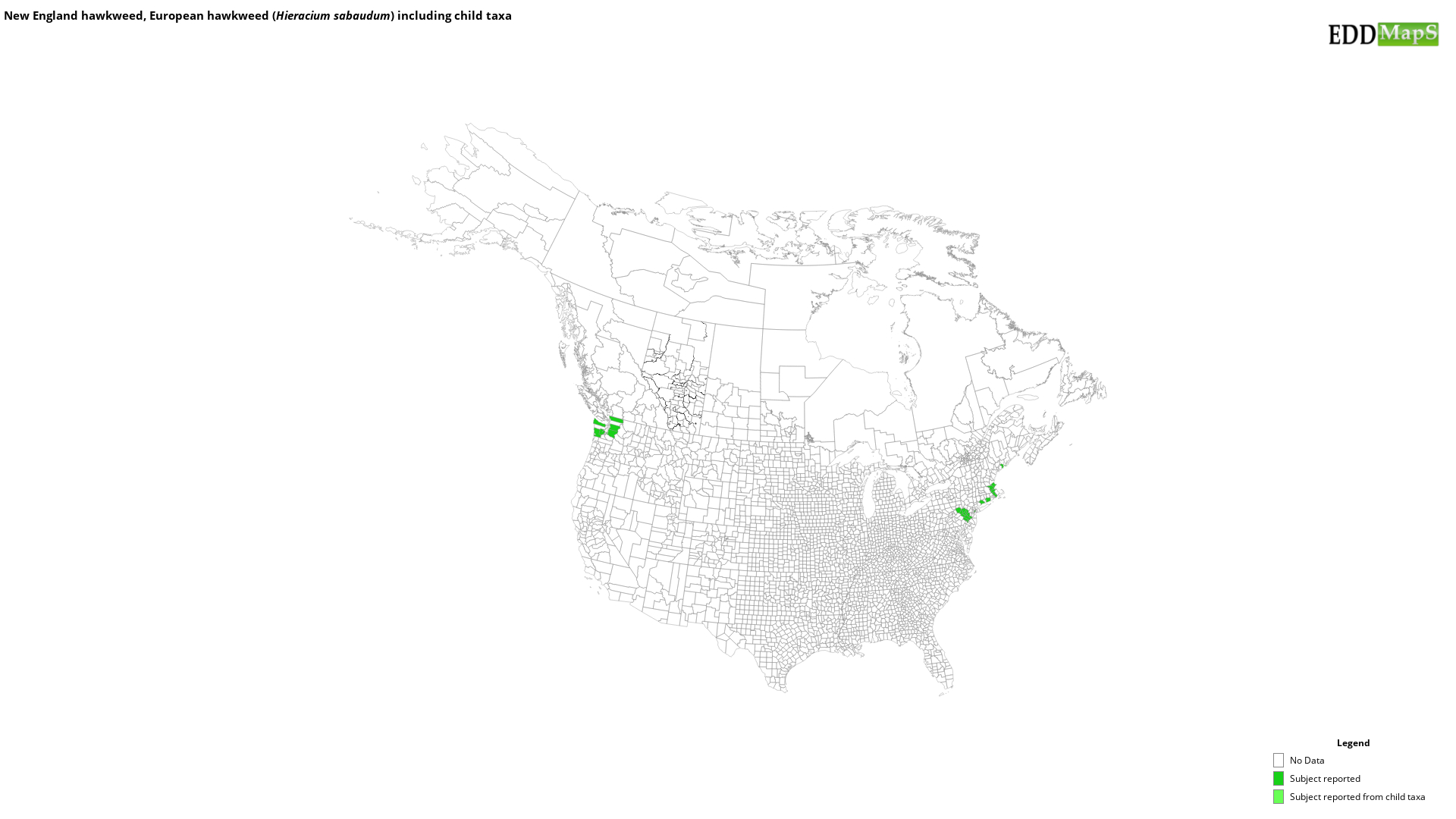New England hawkweed, European hawkweed
(Hieracium sabaudum)
This species is Introduced in the United States
Overview:
Wall hawkweed is a member of the Aster Family and native to Europe. It is a fibrous-rooted, perennial herb with milky latex in the stems and leaves. Wall hawkweed reproduces by seed, and short, stout rhizomes.2It lacks stolons.1Seeds are produced by apomixis - asexually - as non-native hawkweeds are polyploids (n=9), as opposed to the native diploid hawkweeds. Occasional sexual reproduction occurs, facilitating out-crossing and hybridization.1
Hawkweeds develop a low rosette of basal leaves before producing a flowering stem. Dandelion-like flowers are borne at the ends of stems and when mature produce a dandelion-like puffball of seeds that are wind-dispersed.
Non-native hawkweeds exhibit many characteristics of an invasive plant: high seed production and germination rates, asexual seed production, wind-dispersed seed, vegetative reproduction via rhizomes, stolons, and root fragments, and rapid growth.1 A few invasive hawkweed species are popular ornamentals. All of these characteristics facilitate rapid colonization and monopolizing of resources. An undetected patch of hawkweed has great potential to become an un-eradicable infestation.
Habitat
Hawkweeds prefer well-drained, coarse-textured soils, moderately low in organic matter, in mesic habitats.1
Identification:
Stems: Stems are erect and strong, and the lower stem is densely covered with bulbous-based, long simple hairs. Multiple stems. Plants grow 40-130 cm tall.1
Leaves: Leaves are oblong and narrowly tapered to a long petiole. Leaf margins are toothed and the margins flat (not rolled). Lower leaf surfaces bear hairs similar to the stems, the upper surfaces may bear the same hairs or be hairless. Basal leaves are absent or fall off during flowering. Stems leaves are many (-+50), clustered at the base, and become reduced in size going up the stem. Leaf size ranges from 2-18 cm long and 1-4cm wide.2
Flowers: Plants produce 3-12 yellow flower heads in open, flat-topped clusters at the ends of stems.1 Involucral bracts lance-shaped and graduated, and are covered with glandular as well as long, simple hairs.2Flower stems bear non-glandular and stellate hairs. Fruits are achenes 2.5-3.5 mm long with a pappus tan to off-white.2
Prevention:
Learning to recognize hawkweeds from the many yellow-flowered members of the Aster Family is key to prevention. Hairs are an important characteristic of non-native hawkweeds and also in distinguishing between species. Rhizomes and stolons facilitate rapid colonization of a patch of ground. Long-term management of hawkweeds requires maintaining healthy forbs and grasses - fertilization of desirable vegetation can result in out-competition of hawkweeds. Re-seed disturbance in areas susceptible to hawkweed invasion.
Control:
Grazing: Unknown. Invasive plants should never be considered as forage.
Mechanical: Mowing before flowering will prevent seed production of taller plants but will not prevent reproduction via rhizomes. Hand digging of small infestations where all roots can be removed may be effective. Root fragments can generate new plants, therefore any mechanical tilling/cultivation would be ineffective.
Chemical: Hexazinone, 2,4-D, and glyphosate are registered for use on Hieracium spp./hawkweeds. Always check product labels to ensure the herbicide is registered for use on the target plant in Canada by the Pest Management Regulatory Agency. Consult your local Agricultural Fieldman or Certified Pesticide Dispenser for more information.
Biological: None researched to date specifically for Hieracium sabaudum.
1Wilson, Linda. Key to Identification of Invasive and Native Hawkweeds in the Pacific Northwest. British Columbia Ministry of Forests and Range, Forest Practices Branch, Invasive Alien Plant Program.
2Hieracium sabaudum. Written Findings of the Washington State Noxious Weed Control Board. Draft stage, July 2007. Accessed: October 2014.
Maps
EDDMapS Distribution - This map is incomplete and is based only on current site and county level reports made by experts, herbaria, and literature. For more information, visit www.eddmaps.org
State Lists - This map identifies those states that have this species on their invasive species list or law.
Taxonomic Rank
| Domain: Eukarya |
| Kingdom: Plantae |
| Phylum: Magnoliophyta |
| Class: Magnoliopsida |
| Superorder: Asteranae |
| Order: Asterales |
| Family: Asteraceae |
| Subfamily: Cichorioideae |
| Tribe: Cichorieae |
| Genus: Hieracium |
| Hieracium sabaudum |
References
Common Name Reference: USDA, NRCS. 2010. The PLANTS Database. National Plant Data Center, Baton Rouge, LA, USA.
Scientific Name Reference: USDA, NRCS. 2010. The PLANTS Database. National Plant Data Center, Baton Rouge, LA, USA.


